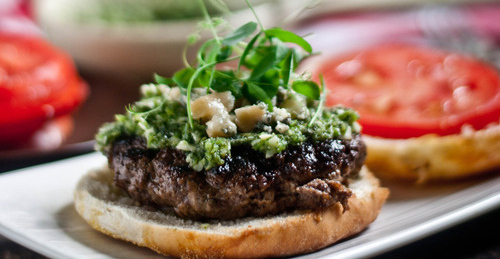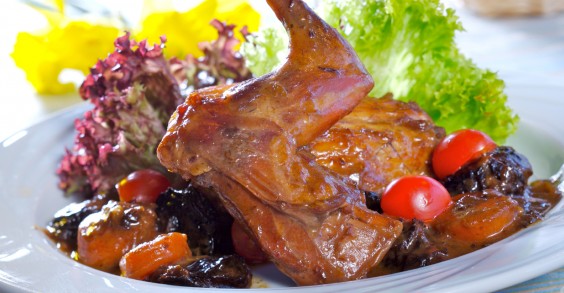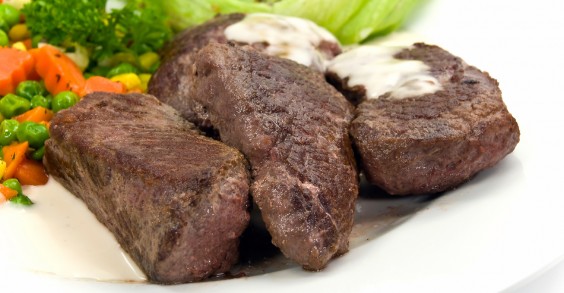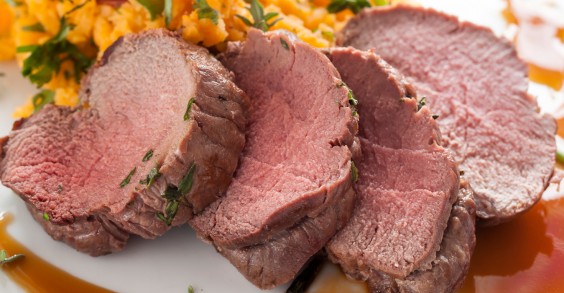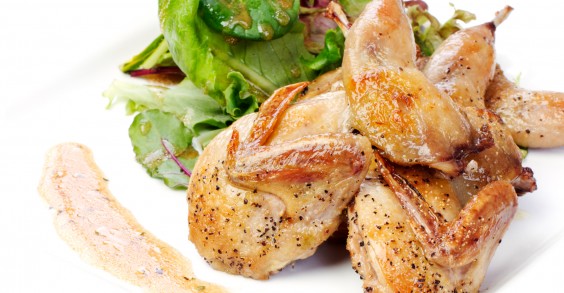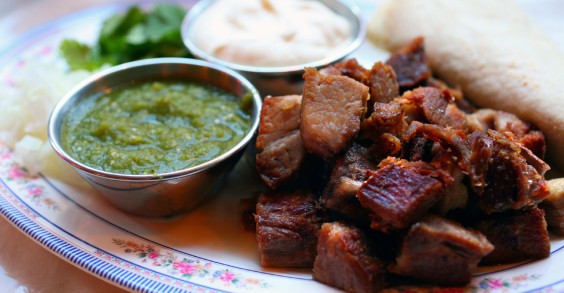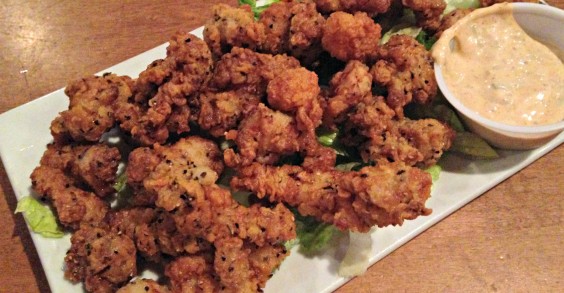Most adventurous eaters have probably gone beyond the basic burger to try duck or even bison. But ostrich, goat, or alligator? Aren’t those animals that you’d find in a zoo—not on a plate?
More and more restaurants and chefs are incorporating non-traditional meats as a different but delicious option for the health-savvy, environmentally conscious, or simply curious consumer. Turns out, many of these exotic meats are actually lower in fat, higher in protein, and just as tasty as traditional beef or pork cuts that make up the majority of meat in the standard American diet.
Plus, eating a wider range of meat is better for the environment. With more people worldwide adding meat to their diets, we can no longer rely on typical livestock to fulfill those needs, especially with growing environment concerns such as water shortages, less available farmland, and global warming. That means we need to look outside of cows, pigs, and sheep when it comes to what we put on our plates.
While you’ve probably never seen these cuts of meat come out of mom’s kitchen, they can create surprisingly tasty and healthy meals. Here’s how a few of the non-traditional cuts stack up, both in taste and nutrition.
*All nutritional information is based on a cooked, three-ounce serving as analyzed by the USDA’s National Nutrient Database.
Bison
- Calories (top sirloin, lean): 145
- Fat: 5g
- Saturated Fat: 2g
- Protein: 24g
- Cholesterol: 73mg
Nutritionally, bison (also called buffalo) comes out way ahead of beef: It contains less saturated fat, fewer calories, and four times as much omega-3 fats as industrial beef*. Bison, which is native to North America, makes a healthier alternative for burgers or dishes that traditionally incorporate beef cuts, since it has a similar taste and texture. Some say it even has a sweeter, richer flavor than beef. Bison is also readily available in many grocery or health food stores. Find it in the meat or freezer sections—it’s slightly more expensive than beef.
Rabbit
- Calories: 167
- Fat: 7g
- Saturated Fat: 2g
- Protein: 25g
- Cholesterol: 70mg
OK, it may take a minute to stomach seeing Peter Cottontail on a plate, but bear in mind that rabbits sold for consumption in the U.S. are not actually the cottontail variety. They’re usually crosses between New Zealand and Belgian varieties, Chinese rabbits, or Scottish hares, the USDA reports. Due to its mild flavor and healthy nutritional profile, rabbit is gaining popularity with chefs. One serving has more protein than beef or chicken, plenty of iron, and minerals like phosphorous and potassium. It is also a highly sustainable meat source, as rabbits eat grass rather than grains.
Ostrich
- Calories: 132
- Fat: 3g
- Saturated Fat: 1g
- Protein: 24g
- Cholesterol: 79mg
Although it has two legs, feathers, and wings, ostrich doesn’t taste anything like poultry. In fact, its red meat is described as tasting like a big juicy steak. However, it has significantly more B vitamins (which are critical for a healthy metabolism) than your usual cut of red meat.
Venison
- Calories: 162
- Fat: 3g
- Saturated Fat: 2g
- Protein: 31g
- Cholesterol: 96mg
Venison, which is meat from a deer, has a taste and texture close to beef, but with a slightly more gamey taste. Because it’s so lean, it has fewer calories, and less fat, saturated fat and cholesterol than beef. Plus, it comes with more iron and protein than a usual hamburger. It’s one of the most popular “freezer fillers” (a package many butchers sell with large quantities of meat) in the U.S., and makes great-tasting jerky too.
Elk
- Calories: 124
- Fat: 1.5g
- Saturated Fat: 0.5g
- Protein: 26g
- Cholesterol: 62mg
Though it’s sometimes also called venison, elk is a larger animal than deer and the meat has a different flavor—mild and almost sweet. It has a similar nutritional profile to venison, plus one serving of elk has 100 percent of your daily recommended dose of B-12, and is high in iron, thiamine, phosphorus, zinc, and riboflavin.
Quail
- Calories: 193
- Fat: 12g
- Saturated Fat: 3g
- Protein: 21g
- Cholesterol: 73mg
Quail go by various names in the U.S., including Bobwhite or partridge, depending on the region. Often prepared by roasting whole (similar to the way you would roast a chicken or turkey), a serving of quail provides plenty of protein, along with iron, zinc, and magnesium. It has a stronger flavor than traditional poultry, but when prepared in dishes with sauce, spices, and flavorings, you can hardly tell the difference.
Goat
- Calories: 122
- Fat: 2.5g
- Saturated Fat: 1g
- Protein: 23g
- Cholesterol: 64mg
Goat meat is a nutritional superstar with fewer calories and less fat than beef or chicken. And like rabbits, goats are a sustainable meat source since they graze on grass, not grains. The taste is savory and not as sweet or buttery as beef, but it does offer bold flavor as well as a hint of spiciness.
Alligator
- Calories: 232
- Fat: 4g
- Saturated Fat: 0g
- Protein: 46g
Alligator is low in fat and calories and high in protein—although those nutritional benefits are wiped away when you order it deep-fried, as it usually comes in the South. Gator is actually a white meat with a light-grained texture that many compare favorably to pork and chicken. The choice cut is the tail, which has a mild flavor and a texture similar to veal. The meat is usually purchased frozen but can also be obtained fresh.
*Compare to Traditional Beef Tenderloin
- Calories: 275
- Fat: 21g
- Saturated Fat: 8g
- Protein: 20g
- Cholesterol: 72mg
Are you game? Unlike our ancestors, we don’t have to hunt these animals to try them out. (And actually, if an animal has been hunted, it’s illegal to sell it, according to the USDA.) Instead, game animals are raised on farms and ranches around the U.S. and inspected by the USDA or a similar foreign agency.
Most of the above products are readily available at a store, online, or even at a restaurant near you. Whole Foods’ meat department offers a bevy of options, from bison to rabbit, while a quick Internet search turns up suppliers of alligator, venison, and quail that can be delivered to your door.
Many restaurants are getting into the game—literally. The fast-casual restaurant Ted’s Montana Grill, which has over 50 locations, features an affordable and tasty bison burger, along with other bison-based dishes. Diners at Bareburger, which has 24 locations and is opening several more, can choose lamb, wild boar, elk, bison, or ostrich burgers. Getting even wilder, The Thirsty Koala in New York offers a kangaroo burger for those feeling the pull from down under.
Curious about cooking at home? Keep in mind that game meat tends to be less tender than meat from domestic animals, since they get more exercise and thus have less fat. (If you do see fat, remove it.) And be careful not to overcook it—game meat can toughen up easily, the USDA warns. Instead, it should be cooked slowly with moist heat by braising or with dry heat by roasting. Give it a go and try out one of these recipes for bison or venison burgers.


